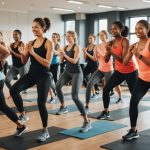Understanding High-Intensity Interval Training (HIIT)
High-Intensity Interval Training (HIIT) has gained popularity for its short, intense bursts of exercise paired with periods of rest or low-intensity activity. This effective fitness regimen can be adapted for various fitness levels, including seniors. Unlike traditional workouts, HIIT workouts often last less than 30 minutes, which makes them appealing for those with tight schedules or looking for efficient routines.
HIIT offers numerous benefits for older adults, such as improved cardiovascular health, enhanced muscle strength, and increased metabolism. It can also bolster endurance and promote better balance, which is crucial for seniors aiming to maintain independence and prevent falls. Engaging in HIIT can result in a greater quality of life and longevity.
Also to discover : Smart Eating Strategies for Seniors 65+: Lowering Stroke Risk Through Dietary Changes
Despite its benefits, there are significant misconceptions about HIIT for seniors. Many believe it can be too strenuous, but with proper guidance and adjustments, seniors can engage in modified HIIT routines without undue risk. It’s essential to differentiate between the myths and facts to encourage seniors to adopt this advantageous exercise method tailored to their abilities. Consulting a fitness professional can ensure a safe and personalised approach to HIIT, maximising its potential benefits.
Safety Considerations
Before embracing HIIT (High-Intensity Interval Training), securing medical clearance from a healthcare provider is crucial. This step ensures that individuals understand their physical limits and any potential restrictions due to pre-existing health conditions. For those with concerns, a medical professional can provide guidance on how to modify HIIT to safely fit their needs.
Also read : Empowering Seniors: Creative Ways to Share Life Stories and Preserve Your Legacy Online
It is vital to recognise and address any pre-existing health conditions that could affect the safety of engaging in HIIT. Conditions such as heart disease, high blood pressure, or joint issues require special attention. By highlighting these issues with a healthcare professional, individuals can adapt their workouts to minimise the risk of injury.
Crafting a safe training environment also plays a significant role in injury prevention. Ensure the exercise space is clear of obstacles and provides adequate ventilation. The surface should be non-slip, and proper footwear must be worn to support the feet and joints. Furthermore, it’s beneficial to maintain a consistent hydration routine and incorporate a thorough warm-up and cool-down phase in every session. Together, these precautions offer a structured approach to mitigate risks, aiding a safer, more effective HIIT experience.
Modifications for Seniors
When it comes to Exercise Modifications for seniors, ensuring safety while maintaining effectiveness is key. Tailored HIIT (High-Intensity Interval Training) adjustments help accommodate different fitness levels. This involves modifying exercises to lower intensity intervals that still enhance cardiovascular health and strength.
Suggested Modifications
Seniors can adapt common exercises such as squats or lunges. Opting for Adaptive Workouts allows movements like seated squats or supported lunges, reducing the risk of injury. The use of chairs for balance or resistance bands for gentle support can aid in maintaining posture and control.
Adjustable Intensity Strategies
Adjusting intensity is crucial. Seniors might shorten the duration of intense intervals or increase rest periods to balance exertion. This makes workouts accessible while still providing physical benefits.
Listening to Your Body
Above all, it’s important for seniors to listen to their bodies during workouts. Recognising signs of fatigue or discomfort allows for necessary pauses or modifications, preventing strain or injury. The focus should always remain on maintaining a comfortable yet challenging pace.
Incorporating these practices into a senior’s HIIT routine can promote a sustainable, enjoyable fitness journey.
Health Benefits of HIIT for Seniors
In recent years, HIIT Research has highlighted the positive effects of high-intensity interval training on senior fitness. These workouts can lead to significant health improvements, making them a beneficial addition to the fitness routines of older adults. Notably, one of the primary benefits is in the realm of cardiovascular health. HIIT helps increase heart rate variability and cardiopulmonary function, offering measurable cardiovascular improvements.
Aside from cardiac gains, HIIT is also linked to enhancements in strength, flexibility, and mobility. This is crucial for seniors as it aids in maintaining independence and reduces the risk of falls. The short bursts of intense exercise followed by periods of rest help build and maintain muscle mass effectively, which is often a concern for the elderly.
Moreover, HIIT has substantial mental health benefits. Regular participation in these workouts can improve mood and reduce symptoms of anxiety and depression. The endorphin release from high-intensity activities also provides a natural mood boost, promoting overall well-being. Together with the senior fitness benefits related to physical health, the mental health aspect further solidifies the role of HIIT as a comprehensive fitness regimen for the senior population.
Sample HIIT Workouts for Seniors
Introducing HIIT routines for seniors can be an invigorating way to boost fitness and overall health. By tailoring workouts to accommodate different fitness levels, seniors can enjoy this efficient exercise method safely.
Beginner HIIT Workout
Starting with beginner HIIT plans, seniors can engage in gentle workouts that involve low-impact exercises such as marching in place, gentle arm circles, and seated leg lifts. A suggested routine could include performing each exercise for 30 seconds, followed by a 30-second rest, repeated for four cycles. This structure allows for gradual conditioning while enjoying the benefits of HIIT.
Intermediate HIIT Workout
Once comfortable with beginner routines, seniors can progress to more challenging HIIT routines. Intermediate plans could incorporate exercises like standing knee lifts, wall push-ups, and mini squats. Seniors should perform each movement for 40 seconds with a 20-second break, catering to increased stamina while remaining mindful of their limits.
Modifications for Recovery Days
Rest and recovery are crucial components of any fitness programme. On recovery days, seniors can modify their workouts to include stretching and balancing exercises. These activities help reduce muscle soreness, enhance flexibility, and keep the body moving without overexertion. Incorporating band exercises or light yoga can offer a gentle yet effective way to promote recovery.
Expert Advice and Testimonials
Incorporating High-Intensity Interval Training (HIIT) into a senior’s fitness routine can be invigorating with the right guidance. Fitness Professional Advice suggests starting with small intervals and gradually increasing intensity. Certified trainers emphasise the importance of knowing one’s limits to prevent injuries and maintain steady progress. Seniors should seek tailored programmes that consider existing health conditions, ensuring exercises fit their abilities.
HIIT Testimonials from seniors reveal uplifting stories of transformation. For example, Mary, a 68-year-old retired teacher, credits HIIT with improving her stamina and mental clarity. Engaging in routines designed with professional oversight supports successful outcomes. These stories highlight not just physical but emotional benefits as well.
Overcoming challenges requires dedication and strategy. Tips for staying motivated include setting realistic goals and celebrating incremental achievements. Seniors might also find it helpful to partner up with a friend or join a community class, fostering a sense of camaraderie. With expert insights and peer stories, the journey toward enhanced fitness becomes an attainable and enjoyable pursuit.
Resources for Further Reading
For those interested in exploring new ways to enhance senior health education and fitness, there are various resources available. Books and articles focused on fitness guidelines can provide comprehensive insights into the benefits and methods of High-Intensity Interval Training (HIIT) for seniors. These materials often highlight approaches tailored to accommodate varying fitness levels and health conditions.
Online platforms are abundant with HIIT resources. These platforms offer instructional videos and interactive content that can guide seniors through exercises safely and effectively. Such content is designed to be easy to follow, often accompanied by detailed explanations and modifications suitable for different capabilities.
Additionally, community programs and local resources present great opportunities for seniors wishing to engage in HIIT activities. These programs often include group classes tailored for senior participants, encouraging social interaction and providing a supportive environment.
Embracing these resources can aid in developing a personalised HIIT routine, promoting a healthier lifestyle, and supporting long-term fitness goals. By leveraging these educational tools, seniors can confidently explore HIIT while adhering to safe practice standards.











